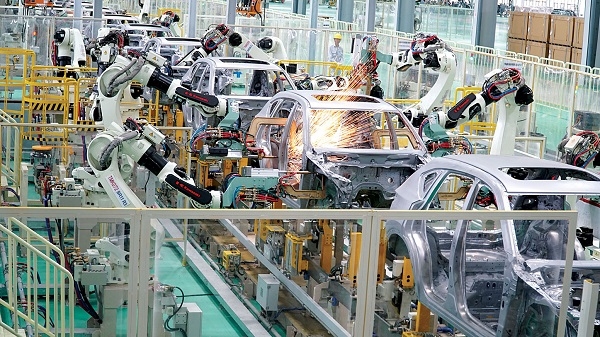 Economy
Economy


|
| The mechanical industry acts as a driving force for other sectors to develop. Photo congthuong.vn |
HÀ NỘI — Total demand of the domestic mechanical market by 2030 is estimated to reach about US$300 billion, according to the Việt Nam Association of Mechanical Enterprises (VAMI).
At present, Việt Nam's mechanical industry only meets about one-third of the demand for mechanical products in the country, the association said.
The demand for machinery and equipment for industrial projects such as thermal power, hydroelectricity, chemical, mining and mineral processing is about $120 billion. Equipment and materials for constructing the North-South high-speed railway system is valued at about $20 billion; the subway system(??), about $10 billion; and the automobile industry, about $130 billion.
Accordingly, the development opportunity of Việt Nam's mechanical industry is substantial, according to the association.
At present, Việt Nam has signed many trade agreements, and multinational companies are expanding to find joint venture partners and set up production factories in Việt Nam.
The trend of moving supply chains is a great opportunity for many businesses, including the mechanical engineering industry.
The Prime Minister has approved a strategy to develop Việt Nam's mechanical engineering industry by 2025.
The overall target of this strategy is that by 2035, Việt Nam's mechanical engineering industry will be developed with the key fields having advanced technology and product quality meeting international standards. At the same time, domestic mechanical engineering products will participate further in the global value chain.
The industry will also have a qualified workforce and actively develop research, design and manufacture mechanical products to meet the needs of the domestic market.
According to Lê Thu Quý, director of the Institute of Mechanical Engineering's Training Centre, to develop the domestic mechanical engineering industry, Việt Nam needs to determine the market demand and fields the sector can compete in.
In addition, to create favourable conditions in development for enterprises, mechanisms and policies must be flexible to encourage enterprises to invest in expanding production and increase localisation. The State must pay attention to the development of metallurgical mechanics and supporting industries.
Economic expert Vũ Đình Ánh has also suggested that to achieve the goal it is necessary to have policies on increasing the localisation rate of the mechanical engineering industry, increasing the value of domestic production.
A representative of Thaco Auto said to develop its mechanical field, the company had promoted the development of modern technology platforms and value chains from research and development of the product to production and supply. These are important factors for the company to improve product quality, reduce costs and create competitive advantages.
VAMI chairman Đào Phan Long said if the domestic mechanical engineering industry wants to receive many orders and participate in the export chain, it needs to renew equipment and technology to manufacture spare parts and components according to demand of foreign partners.
In the future, the mechanical engineering industry requires the development of materials, moulds, processing and manufacturing, not just cutting, so the enterprises are forced to link up and go deep into the global value chain, he said.
The Ministry of Industry and Trade has also said that to support mechanical enterprises, it will continue to improve the operational efficiency of two technical centres supporting industrial development in the North and the South.
The two centres have supported some mechanical enterprises in training production and business management and increased capacity to meet international standards.
The centres have also cooperated with multinational corporations in Việt Nam such as Toyota, Mitsubishi and Canon to find suitable local suppliers for participating in the value chain of these corporations.
In addition, the ministry will continue the development of supporting industries for the domestic mechanical engineering industry.
According to the ministry's Department of Industry, with about 25,000 mechanical enterprises in operation, accounting for nearly 30 per cent of enterprises in Việt Nam's processing and manufacturing industry, the domestic mechanical engineering industry has gradually increased the localisation rate.
Quý said Việt Nam's mechanical engineering industry has three strong sub-sectors - motorcycles and motorcycle spare parts, household mechanics and tools, and auto and auto parts. The three sub-sectors account for nearly 70 per cent of the domestic mechanical engineering industry's production value.
The industry has produced and assembled almost all types of passenger cars and trucks. Motorcycle production has had a localisation rate of 85-95 per cent, meeting domestic and export demand. Typical enterprises in the automotive field include Vinfast, Thành Công and Thaco.
However, Ánh pointed out that besides Vinfast, Thành Công and Thaco, the remaining popular domestic mechanical enterprises were small-scale with low competitiveness and low tech equipment.
In addition, the product quality is not good, the prices are high, and no key industrial products can compete with imported products.
According to VAMI, over the years, a series of limitations and weaknesses in management, policies, and the enterprises themselves, have left the development of the mechanical industry unable to meet market requirements.
Therefore, many large projects in construction, transportation, irrigation works, oil and gas, marine economy, shipbuilding, automobiles and motorbikes have mainly used mechanical products imported or manufactured by foreign direct investment enterprises. — VNS